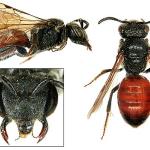Sphecodes rufescens VON HAGENS 1874
A scarce species, found from Cornwall to Kent to the north of England. It is found rarely in Wales and reported from Ireland in O’Connor et al. (2009), but is not known from the Channel Islands.
Abroad, a Palaearctic species; known in the south from central Spain east to Greece and Azerbaijan and in the north from southern Fennoscandia east to Siberia (S Roberts pers. comm.).
Listed as Nationally Notable/Nb in Falk (1991) (now known as Nationally Scarce).
Found in calcareous grassland, open deciduous woodland and moorland edges.
Univoltine; the female flies from late May to mid August and the male from mid July to the end of August (Falk, 1991).
The parasitic behaviour of this bee has apparently not been observed. It is believed to parasitise Lasioglossum fulvicorne (Kirby) and Lasioglossum fratellum (Pérez); possibly also other Lasioglossum such as laticeps (Schenck), pauxillum (Schenck) and rufitarse (Zetterstedt) (Falk, 1991).
Flower visits in Britain, for nectar only, are known for a cinquefoil, fennel and wild carrot (Falk, 1991).
No data available.
2016


